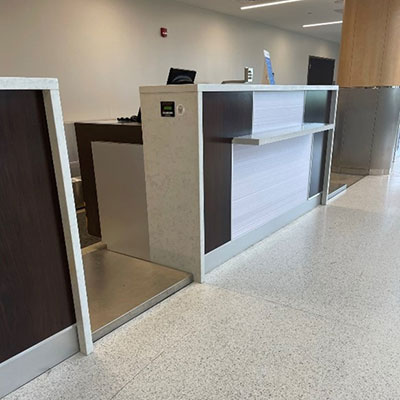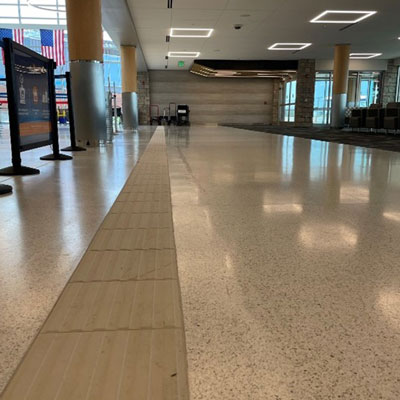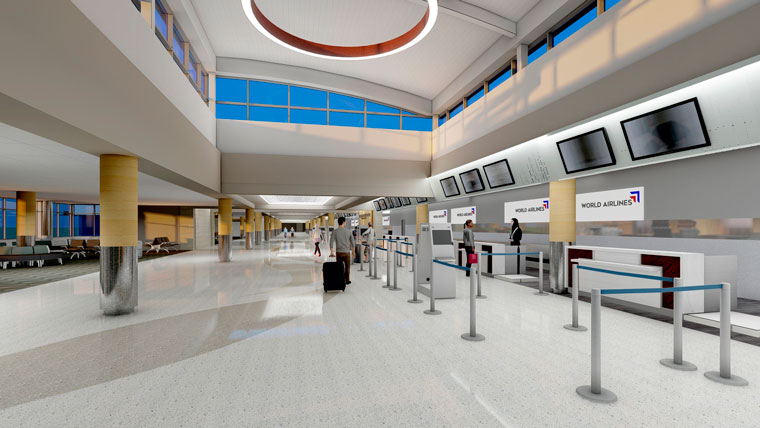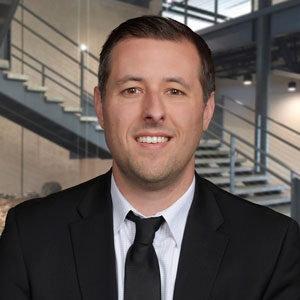Based on Centers for Disease Control and Prevention (CDC) statistics, one in four adults in the United States live with a disability. As airport terminals serve millions of diverse passengers a day, there’s no doubt this includes passengers with disabilities. When designing the built environment, we are all familiar with the Americans with Disabilities Act (ADA), the requirements it places on our facilities, and the importance of ADA compliance. However, as today’s airports become increasingly experience-based, we as designers should strive to exceed the bare minimum and push toward Universal Design to create a more inclusive experience for all passengers.
Luckily, there are many relatively simple ways this can be accomplished at varying levels of cost and complexity. In a recent experience with a client, I was able to gain valuable knowledge on how to accommodate passengers of various types of disability.
Fort Wayne International Airport: Universal Design case study
Fort Wayne International Airport sits in proximity to a number of large groups that provide services to disabled populations. including some key project partners like Northeast Indiana Disability Advocacy Coalition (NEIDAC), AWS Foundation and Turnstone. NEIDAC served as a resource to our design team throughout the design phase of the project, bringing their unique perspectives on Universal Accessibility and giving us feedback on our design concepts. AWS Foundation, headquartered in Fort Wayne, helps children and adults with enduring intellectual, developmental, and physical disabilities live as independently as possible by providing grants to community partners in support of their vision. Turnstone is an organization that, among many things, hosts various sporting events throughout the year—events that bring disabled athletes to the area from all over the country. Due to the strong connections of these organizations to the community, the airport experiences a higher-than-average traffic level from passengers with disabilities.
When the airport started preparing for its current two-phase airport expansion and renovation project, it saw a unique opportunity to assess their airport from the perspective of the disabled public. Airport leadership staff conducted separate tours of their terminal facilities with people with different disabilities to gain an assessment of where they could improve. With this information, the airport asked Mead & Hunt and the rest of our design team to implement design features throughout the facility to make their airport experience as universally accessible as possible.
Below are the features being implemented, many of which are easily adaptable to airports of different sizes.
Accessible Design Features
- Beginning at the curbfront, the entire length of the passenger unloading area utilizes a rolled curb style design. This allows for easy loading and unloading of passengers with wheelchairs, eliminates the need for passengers with upper body mobility issues to lift their roller bags, and provides a detection surface for visually disabled passengers with canes. A number of ADA van unloading spaces are also included along pick-up and drop-off areas.
- Inside the ticket lobby, low-profile baggage scales that sit only one inch above the floor are utilized at ticketing counters to accommodate passengers with limited upper body mobility and strength who may not be able to lift their luggage.

Throughout the facility:
- All casework including ticket counters, gate counters, rental car counters, and information desks will include accessible-height countertops.
- For passengers with varying visual disabilities, all signage will be of high-contrast colors for ease of reading, and the terrazzo flooring will include a high-contrast pattern that flows in the direction of travel for intuitive wayfinding. Additionally, a tactile “cane trail,” similar to truncated domes used at exterior crosswalks, will follow the path of circulation, allowing passengers with canes to easily navigate the terminal.
In the concourse area:
- Lounge-style sofa seating with no intermediate armrests is provided at all gates. This offers passengers with limited to no mobility a place to lay and rest while their mobility aid is loaded onto the aircraft.
- For passengers with Autism spectrum disorder (ASD) or other cognitive disabilities, a Sensory Room is provided. Sensory Rooms are quiet escapes which include various tactile, audio, and visual distractions in an acoustically-treated space for cognitively disabled passengers to decompress and recenter prior to their travel. Funding for the furnishings in this space was provided by AWS Foundation.
- A Service Animal Relief Area (SARA) is provided to offer an area of relief for the service animals that assist passengers with various types of disabilities such as visual, audio and mobility.
- A Kid’s Play Area is provided with accessible play activities.
- An adult-sized changing table, also funded by the AWS, is being provided at all Family/Unisex toilet facilities. These are height-adjustable tables that provide for safer transfers, comfortable positioning, and a secure space for caregivers to aid weakened or disabled adults who may need assistance with changing or getting dressed.
- An assistive listening system, also known as a “hearing loop,” is provided throughout the concourse. This allows passengers with telecoil-equipped hearing aids to hear public announcements being made at gates and throughout the airport.

Aside from these current projects, Fort Wayne International Airport is also the first airport in Indiana to roll out the Hidden Disability Sunflower Program. This program provides a visual cue, such as a lanyard or bracelet, to identify those with hidden or invisible disabilities who may need extra patience, care, and explanation during their travel experience. This reminds airport staff and other passengers to exercise extra compassion and empathy when working and interacting with these passengers and their families.
Once their expansion and renovation project is completed, Fort Wayne International Airport hopes to continue to work with their local partners to be as accessible as possible as both trends and the needs of their community continue to change.
Why does Universal Design matter?
While this is not intended to be an all-inclusive list of what can be done to implement Universal Design at an airport, it certainly provides a good starting point. Every airport is at a different place with respect to planning, development, and financial resources. Airports need not, and should not, rely on having groups like NEIDAC, AWS Foundation, and Turnstone nearby to consider implementing Universal Design. The number of disabled travelers is likely to increase as airports continue to expand and evolve. The best thing airports can do is utilize the resources available to them to become educated about how to accommodate as many people as possible to achieve a wholly inclusive terminal facility. As was the case with FWA, you may even be able to partner with local groups to obtain funding for accessible features.
As the lead architect on this project at Fort Wayne International Airport, I am proud of the work we are doing toward an equitable space for all passengers, and I appreciate the leadership of the FWA airport director and operations team in emphasizing inclusion and Universal Accessibility.



